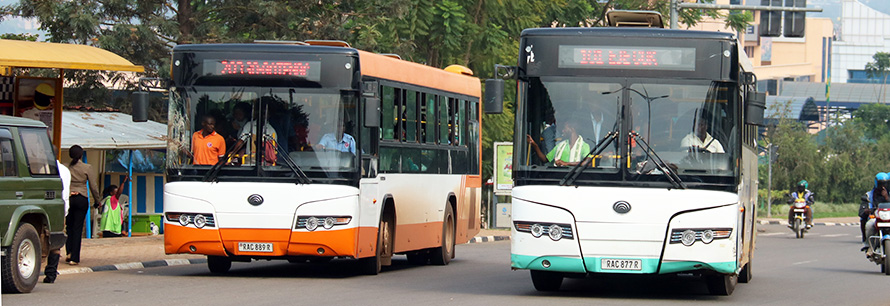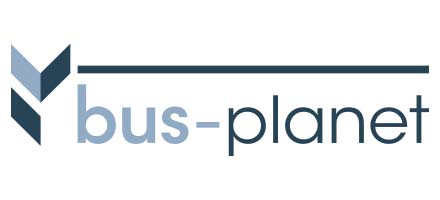KIGALI
Transport in Kigali
Kigali is the capital of Rwanda, with over 1 million inhabitants.

November 4, 2019: RFTC explains the Generation 2 bus services to be introdiced in Kigali in 2020. See the article in the New Times.
August 30, 2019: RFTC introduced 11 large buses with ramps for disabled people, on the “blue” and “green” routes. See the article in the New Times.
August 2019: The city is considering a six-months extension of the contract of the three urban operators KBS, Royal Express and RFTC.
Situation mid 2016:
In August 2013 public transport in Kigali was completely reorganized. The city was divided into four transport zones which were tendered. Three companies won four five-year tenders:
–Kigali Bus Services won zone 1 and operates the 100-series routes from the center to the east of the city. Its buses are white and light green. It operates full size Yutong buses, Toyota Coaster midibuses and a few minibuses. For the company website click here, for their Facebook pages click here. For a map of main routes click here.
–Royal Express won zone 2 and operates the 200-series routes from the center to the south-east of the city. Its buses are white and orange. It operates full-size Yutong and Hyundai buses as well as Toyota Coaster midibuses and a few minibuses. For a map of main routes click here.
–RFTC (Rwanda Federation of Transport Cooperatives) won zone 3 and operates the 300-series routes from the center to the northern part of the city. Its buses are white with dark green striping. It operates Toyota Coaster midibuses and Toyota Hiace minibuses.
–RFTC also won zone 4 and operates the 400-series routes from the center to the western part of the city. Its buses are white with blue striping. It operates Toyota Coaster midibuses and Toyota Hiace minibuses. For a map of main routes click here.
The main routes (from the city center) are trunk routes and there is some overlap between routes of different zones. Only large buses and Toyota Coaster midibuses are allowed in the center. The Toyota Hiace minibuses are only allowed on outer routes, mainly on intrazonal and some interzonal services. The Toyota Hiace (18 seats) and Toyota Coaster (25 seats) are only allowed to carry seated passengers, the larger Yutong and Hyundai buses are allowed to carry standing passengers as well.
A new spacious bus station for urban routes was built end of 2015 to the west of the center. Other bus stations that are transport nodes for urban as well as regional routes are the main Nyabogogu bus station to the west of the center, Remera and Kimironko to the east and, recently, Nyanza to the south. With the introduction of the new system services were extended to run from 05:00 in the morning to 23:00 in the evening, with rush hours between 06:30 to 08:00 and 17:30 to 20:00. Click here for a map with the location of the bus stations.
Smart cards were used by KBS but withdrawn later. A new smartcard system (Twende) for urban services was introduced in 2016. Paper tickets sold in buses are (mid 2016) RWF 250 (around US$ 0.30), daily smart cards for unlimited travel are RWF 600 and monthly passed for unlimited travel are RWF 10,000 (around US$ 12). 400 buses were equipped with WiFi in 2016.
Transport is under the responsibility of the City of Kigali and RURA (Rwanda Utilities Regulatory Authority, established in 2013). RURA issues licenses, sets tariffs and exercises controls. An (outdated) list of urban routes and tariffs can be found here (see under “latest news” on the right of the page).
History
At independence of Rwanda in 1962 Kigali was a mere village with some 6,000 inhabitants. It became the country’s capital because of its more central location than the traditional Nyanza and administrative Butare capitals. Since then the city has grown rapidly to over one million inhabitants. Kigali is built on four ridges with elevation varying from around 1,300 to 1,600 meters. The terrain makes for a complicated road system.
Organized public transport came in the mid-1970’s when minibuses started plying city roads. The system expanded with the city. The minibus owners were organized in transport cooperatives under the umbrella of ATRACO (Association of Transport Cooperatives). By 2010 large numbers of minibuses plied the city roads, competing for passengers and creating more and more traffic jams. ATRACO was dismantled in 2011 because of mismanagement and became RFTC (Rwanda Federation of Transport Cooperatives), in Kigali called RFTC Town Service. The vast majority of the fleet were Toyota Hiace minibuses and Toyota Coaster midibuses, white with yellow trim. Many were secondhand imports from Japan, built for right-hand drive with the doors on the “wrong side”.
Also during the mid-1970’s, state company ONATRACOM was established when Japan donated Nissan buses which were used for transport of civil servants in the city and for transport over bad roads in rural areas. The urban services disappeared after the 1994 events.
As part of an ambitious plan to develop the city of Kigali into a modern metropolis public transport was reorganized. The Singaporian company Surbana Ltd proposed an master plan in 2010 in which new forms of public transport, Bus Rapid Transit, and pedestrian areas with decentralized commercial and living areas play a major role. As a first step Kigali city services were divided into four zones and a tender resulted in the award of zone 1 to Kigali Bus Services, zone 2 to Royal Express and zones 3 and 4 to RFTC. The new system was launched on August 30, 2013. Under the five year concession companies had to bring in large buses, minibuses were banned from the city center, fixed routes had to be adhered to and operation hours from 5 AM until 11 PM had to be respected. After some teething problems the system proved to be a big improvement, with less traffic congestion because of the competing minibuses and prolonged operational hours. KBS and Royal Express brought in large buses (Zhonda, Yutong and Hyundai) though also still operating Toyota Coasters. RFTC operates large numbers of Toyota Coasters with smaller numbers of Toyota Hiace on some routes that do not come to the city center. Standing passengers are allowed in the large buses but not in the Toyota Coaster and Hiace. KBS buses are white and light green, Royal Express buses are orange and white, RFTC zone 3 buses are white with dark green lining and RFTC zone 4 buses are white with blue lining. Zone 1 routes are numbered in the 100-series, zone 2 in the 200, zone 3 in the 300 and zone 4 routes in the 400-series. Main routes (trunk routes) have the lowest numbers in a series, intra- and interzonal routes have higher numbers.
The number of buses in Kigali is give as over 800 though is probably smaller as operational availability is less than 100%. Especially the large buses are prone to accidents and maintenance poses more of a problem as the buses are imported directly. The Toyota Coaster is the standard bus in Rwanda and there is a large Toyota dealer, Akagera Motors, supplying, financing and maintaining them. Hyundai now also has a representative dealing with large buses.
Anticipating developments Kigali Bus Services was founded and started on a trial scale in 2006 with a small number of yellow secondhand buses. This was relatively successful and a series of 20 Zhonda city buses was ordered from China. These proved problematic and subsequently Yutong buses were bought. Though the city of Kigali supported the introduction of a company with large buses, the company faced many challenges. The competing RFTC Town Service Toyota minibuses were keen in hindering the KBS buses and police was sometimes prohibiting the large buses from stopping at designated bus stops, as they were unaware that the system was allowed. As a consequence, and awaiting the new system that was announced, KBS withdrew its urban services and used its buses on the regional service from Kigali to Musanze and Guisenyi. As soon as the new urban system in Kigali became operational the regional services were discontinued and all buses were assigned to the urban system. Royal Express was a fairly new company operating some Toyota Coaster on city services but really grew to a full size operator when the new services commenced in August 2013. RFTC was already and established operator.







